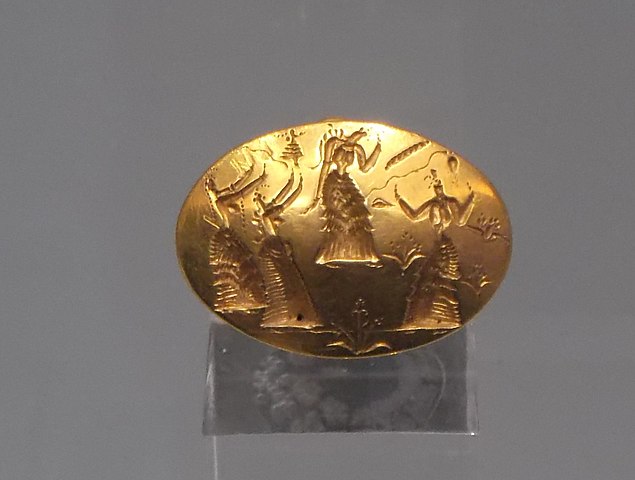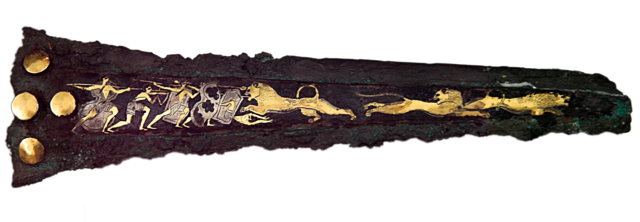Ariadne's Tribe: Minoan Spirituality for the Modern World
Walk the sacred labyrinth with Ariadne, the Minotaur, the Great Mothers, Dionysus, and the rest of the Minoan family of deities. Ariadne's Tribe is an independent spiritual tradition that brings the deities of the ancient Minoans alive in the modern world. We're a revivalist tradition, not a reconstructionist one. We rely heavily on shared gnosis and the practical realities of Paganism in the modern world. Ariadne's thread reaches across the millennia to connect us with the divine. Will you follow where it leads?
Find out all about Ariadne's Tribe at ariadnestribe.com. We're an inclusive, welcoming tradition, open to all who share our love for the Minoan deities and respect for our fellow human beings.
Minoan vs. Mycenaean Art: What's the difference?
When two societies engage in extensive cultural exchange, there's usually still a distinction between the two.
The whole eastern Mediterranean was a single giant cultural exchange milieu during the Bronze Age. The Minoans borrowed from the Levant, Egypt, and Mesopotamia. The Egyptians borrowed from the Minoans, the Levant, and Mesopotamia. The Mesopotamians... You get the idea.
And the Mycenaeans borrowed from the Minoans. A lot. To the point that sometimes it's hard to tell what's Minoan and what's Mycenaean when we're looking at art and artifacts. Sometimes I think the Mycenaeans were trying to be Minoan, in some respects. Or at least take on the Minoans' style, their religion, and perhaps their level of economic success, which the Mycenaeans must have envied.
Take, for instance, the famous Lion Gate of Mycenae, pictured at the top of this post. Its art style is heavily Minoan, with elements we recognize from Minoan art: a pair of lions flanking a tapered column that sits atop an incurved altar. But it's located in Mycenae. It was built there, so we know it's Mycenaean and not Minoan. Except that it's in a fully Minoan style.
So the provenance of the item gives us the beginning of an answer to our question. Did it come from a Mycenaean site? Can we tell pretty surely that it was made there and not imported from somewhere else? Then it's Mycenaean, even if it imitates Minoan style.
But sometimes Minoan objects were imported into Mycenaean areas and vice versa. Then there's the Mycenaean occupation, the couple of centuries after the Thera eruption when the Mycenaeans took over at Knossos and attempted to take over all of Crete. So that was a blending of Minoan and Mycenaean culture, art, and religion.
Did you know that all the frescoes from Knossos date to the Mycenaean occupation era?
So technically, they're neither purely Minoan nor purely Mycenaean, but a combination of the two.
Besides provenance, how else can we attempt to distinguish between the two?
Though the Mycenaeans borrowed Minoan iconography and art style, they put their own spin on them. So, for instance, their art is often a bit stiffer and more formal than Minoan art. Compare this fresco from the Mycenaean site of Thebes:

Image CC BY 4.0 via Wikimedia Commons
to these from the Minoan site of Akrotiri:

Image CC BY 4.0 via Wikimedia Commons
and

Image CC BY 4.0 via Wikimedia Commons
This stylistic difference also shows up in the gold seal rings that were popular in both cultures. Here's a Mycenaean one:

Image CC BY 4.0 via Wikimedia Commons
and a Minoan one for comparison:

Image CC BY 4.0 via Wikimedia Commons
There is also some distinction in subject matter between Minoan and Mycenaean art. Before the Mycenaean occupation, there were no horses on Crete. The Mycenaeans imported them along with chariots, two items that were important to their culture. So when you find horses and/or chariots in the art, they're from the Mycenaean occupation era and are very much a product of Mycenaean influence.
While bull leaping appears in Minoan art, the hunting and capture of wild bulls is very much a Mycenaean motif. We find it on the famous gold Vapheio cups, one of which may have been of Minoan manufacture, made specifically for export to the Mycenaean market. Interestingly, both cups are a shape developed by the Minoans for their ceramics long before the Vapheio cups were made.
Lion hunting was also a popular motif in Mycenaean art, but one that doesn't show up in Minoan art. This Mycenaean bronze dagger with gold and silver inlay is a good example of this subject:

Image CC BY 3.0 via Wikimedia Commons
Other kinds of hunting occasionally appear in Minoan art, with the prey usually being ibex or wild goats. But no lions. There have never been lions on Crete, but there were lions in the mountains of northern Greece during the Bronze Age. It's possible the Mycenaeans borrowed the lion-hunting motif, as a sign of the prowess of their leaders, from the Egyptians, who used lion hunting with that meaning in their art. Like I said, the whole eastern Mediterranean was one great big cultural melting pot during the late Bronze Age.
So there is one sense in which it's pretty easy to tell whether an artwork or artifact is Mycenaean or Minoan, based on where it was made and who it was made for. Made at a Mycenaean site for use by Mycenaeans? That counts as pretty well Mycenaean in my book.
But what if it was made locally by Mycenaeans, but in the Minoan style? What about the Vapheio cup that was probably made on Crete by Minoans, but in the Mycenaean style, for export to the Mycenaeans?
Clear as mud. LOL
So if you're trying to determine whether an artwork or artifact is Mycenaean or Minoan, you need to decide what those terms mean in the context you're talking about. Do they refer to the item's provenance, that is, the place where it was made and used? Do they refer to its style and design?
These are all factors we can use to decide which label an item falls under. But ultimately, there will be some pieces that can't be cleanly categorized as just Mycenaean or Minoan. There's so much overlap, we have to allow for some wiggle room with our labels and categories.
I guess we'll just have to learn to accept that not everything is a neat-and-tidy binary. ;-)
Comments
-
Please login first in order for you to submit comments




















